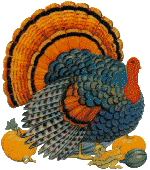 Home
Home
|
Turkey Purchasing Pointers from the National
Turkey Federation Purchase during special value sales and store the bird in the freezer until the thawing time begins. Thaw under refrigeration, in cold water, or the microwave. Refrigeration: Allow approximately 24 hours per four to five pounds to thaw in the refrigerator.
Cold Water: Allow approximately 30 minutes per pound to thaw in cold
water, which is changed every 30 minutes. Do not use warm or hot
water and be sure to change the water every 30 minutes. Fresh Turkey: Hard Chilled/Previously Hard Chilled Turkey:
OTHER TIPS FOR PURCHASING AND PREPARING TURKEY:
Purchase one pound of turkey per person to be served. This formula allows for the holiday meal plus a little left over for the prized turkey sandwich. Ensure that the packaging is intact and avoid purchasing a bird with packaging that has rips or tears.Save on supermarket specials by purchasing more than one turkey. A whole frozen turkey may be stored in your freezer for up to 12 months. Select the size of turkey based on number of servings needed. There is no appreciable difference between female (hen) and male (tom) turkeys in tenderness, white/dark meat ratio or other eating qualities. Hens typically weigh between 14 to 16 pounds and toms 15 pounds on up, so choose the size which best fits the number of dinner guests you expect. Select alternative turkey cuts if you are having a small gathering for the holiday. Other turkey products that are readily available include a turkey breast, tenderloins, cutlets, drumsticks or thighs. Or ask your butcher to cut a whole fresh bird in two halves, roast one half and freeze the other half for a later occasion. |
Razzle Dazzle
Recipes
http://www.razzledazzlerecipes.com
Don't forget to visit our other Recipe site at
That's My Home